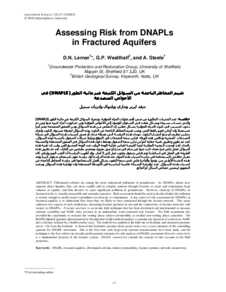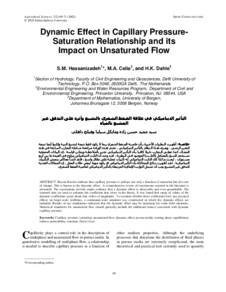وثيقة
Assessing risk from DNAPLs in fractured aquifers.
المساهمون
Wealthall, G. P., مؤلف
Steele, A., مؤلف
الناشر
Sultan Qaboos university
ميلادي
2002
اللغة
الأنجليزية
الموضوع
الملخص الإنجليزي
Chlorinated solvents are among the most widespread pollutants of groundwater. As DNAPLs (dense nonaqueous phase liquids), they can move rapidly and in complex patterns through fractures to reach and contaminate large volumes of aquifer, and then dissolve to cause significant pollution of groundwater. However, clean-up of DNAPLs in fractured rocks is virtually impossible and certainly expensive. Risk assessment should be used to decide whether the pollution is serious enough to justify major expenditure on clean-up or containment. A key aspect of risk assessment for DNAPLs in fractured aquifers is to understand how deep they are likely to have penetrated through the fracture network. This paper addresses two aspects of such predictions: measuring fracture apertures in situ and the connectivity of fracture networks with respect to DNAPLs. Fracture aperture is an in-situ field technique that has been developed and implemented to measure aperture variability and NAPL entry pressure in an undisturbed, water-saturated rock fracture. The field experiment also provided the opportunity to measure the wetting phase relative permeability at residual non-wetting phase saturation. The RADIO (Radial Aperture Determination by the Injection of Oil) method employs a constant rate injection of a non-toxic NAPL into a fracture isolated by a double packer array. The method was applied at the field site in Scotland, and measured apertures out to ~5m from the borehole. It showed that hydraulic aperture (from packer tests) was a poor estimator of the controlling aperture for DNAPL movement. This is the first time such large-scale aperture measurements have been made, and the technique is the first which can provide useful aperture estimates for risk analysis of DNAPL movement. Network connectivity is a fundamental property of the fracture system. DNAPL connectivity extends the concept to take account of the fluid properties.
المجموعة
ISSN
2410-1079
URL المصدر
zcustom_txt_2
Lerner, D. N., Wealthall, G. P., & Steele, A. (2002). Assessing risk from DNAPLs in fractured aquifers. Journal of Agricultural and Marian Sciences, 7 (2), 47-52.
الملخص العربي
تعد المذيبات المكلورة من ضمن أهم ملوثات المياه الجوفية. وتتحرك السوائل الكثيفة غير مائية الطور (DNAPLS) والتي تنساب بسرعة وبشكل معقد في الشقوق للوصول إلى الأحواض الجوفية ومن ثم تلويث أجزاء كبيرة منها ومن ثم تذوب لتتسبب في تلوث المياه الجوفية بشكل خطير. إن التخلص من هذه السوائل ومن الصخور المتصدعة يعتبر أمرا مستحيلا وإن أمكن فهو باهظ الثمن ويجب تقييم المخاطر الناجمة عن التلوث بهذه السوائل لمعرفة مستوى التلوث ولقيام بتدابير تنظيف أو منع انتشار التلوث. تهدف هذه الدراسة إلى معرفة مدى أو عمق انسياب هذه السوائل في شبكة التصدعات الصخرية وتناقش هذه الورقة قياس سعة التصدعات في الموقع وترابط شبكات الشقوق بالنسبة لهذه السوائل. لقد تم تطوير وتطبيق تقنية حقلية لقياس تباين سعة الشقوق وضغط دخول هذه السوائل في الصخور المتشققة والمشبعة بالماء. لقد أوجدت التجربة الحقلية أيضا الفرصة لقياس نفاذية الوجه الرطب عند الوجه المشبع الغير رطب. إن تقنية هذه السوائل تعمل على ضخ معدل ثابت منها غير سام في صدع أو شق معزول ومحمي بطبقتين من العازل. لقد تم تطبيق هذه الطريقة في الحقل في اسكتلندا وتم قياس شقوق وثقوب تصل إلى 5 أمتار. وقد أظهرت الدراسة أن الثقب الهيدروليكي كان معيار خاطئ لاستخدامه في دراسة انسياب هذه المواد. تعد هذه الدراسة أول دراسة تقوم باستخدام شقوق كبيرة وتعد هذه التقنية الأولى من نوعها والقادرة على تقدير سعة الثقوب بشكل أفضل لاستخدامها في دراسة المخاطر الناجمة عن انسياب هذه السوائل. تعد تواصلية الشبكة خاصية أساسية في الأوساط المتشققة وأن تواصلية هذه السوائل وسعت المفهوم ليتضمن خصائص السائل أو المائع.
قالب العنصر
مقالات الدوريات


